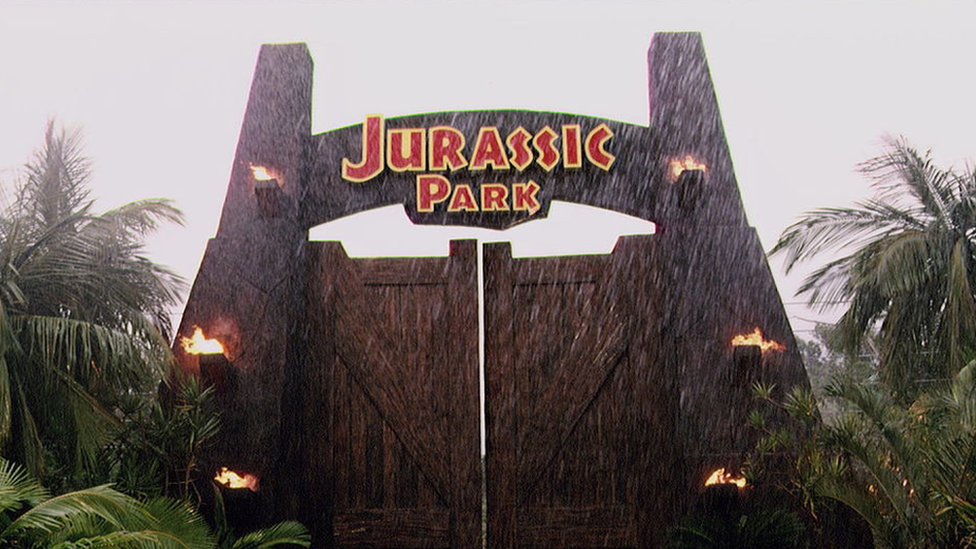Jurassic World Dominion: First images shows dinosaur with feathers
- Published
- comments

Since the first Jurassic Park film came out in 1993, experts have uncovered countless dinosaur fossils which have changed their understanding of how the animals looked and behaved.
It means that the original Jurassic Park movies got a lot wrong, but for a film that is about cloning creatures that existed 65 million years ago, it's probably safe to expect the films to be a little far-fetched.
However, the latest movie Jurassic World: Dominion, due for release next summer, has revealed a first glimpse of the film and some of the dino designs reflect how scientists think the creatures would have looked.
Director of the film, Colin Trevorrow has shared a new image from the opening sequence of the movie, showing a feathered dinosaur in the films for the first time.
The dinosaur called Moros Intrepidus, is shown standing next to the jaws of another much larger predator, possibly a Giganotosaurus.
Speaking to the magazine Entertainment Weekly, Trevorrow explained that the start of the film will begin during the time of the dinosaurs: "It's a bit of a self-indulgent thing for the child in me because I always wanted to see dinosaurs as they were in the Cretaceous period."
Did dinosaurs have feathers?
A 130-million-year-old fossil dinosaur covered with feathers
The first perfectly preserved fossils of feathered dinosaurs were found in China 20 years ago. It proved beyond any doubt that these ancient animals were the ancestors of modern-day birds.
Since then, more and more species of dinosaur have been revealed to have either been completely feathered, or had some feathering scattered across their bodies.
Prof Paul Barrett a researcher at London's Natural History Museum says: "To date, most examples of dinosaur feathers have been found in the meat-eating dinosaurs, known as theropods, which is the group that also includes birds.
"But there's been speculation as to how far back feathers appear in meat-eating dinosaur evolution, and whether feathers might also have been seen in all other dinosaurs."
An artist's impression of what a baby tyrannosaur may have looked like
When it comes to some of the famous fearsome creatures seen in the Jurassic Park and Jurassic World films, one theory is that a young T-Rex may have had a thin coat of fluffy feathers to keep warm.
Which is very different to how the animal is shown in Jurassic Park: The Lost World which came out in 1997.
Scientists have since speculated as to whether the animal shed those feathers as it got older or kept them.
Watch Jenny's report on the dinosaur debate surrounding Jurassic World.
Three things the Jurassic Park movies got wrong
Other than the possibility of a baby T-Rex having feathers, there are several other things which have been proved to be inaccurate as palaeontologists have learned more about dinosaurs.
1. T-Rex
It's not just the baby T-Rex that would've looked different to the film version millions of years ago. The modern-day movie version of the grown-up T-Rex isn't quite right either.
Palaeontologist Jack Horner, who worked as the science adviser for all five Jurassic Park movies to date says the creature could've been much more colourful than the one shown in the films.
In an interview last year, Horner revealed that the original movie director Steven Spielberg made a creative decision because he felt that colourful, feathered dinosaurs "wouldn't be scary enough".
And, unlike the films where the T-Rex struggles to see anything that doesn't move, research also suggests T-Rex probably had excellent vision, similar to a birds of prey such as a hawk or eagle.
2. Dilophosaurus
In the first film, Dilophosaurus was shown as a venom spitting dinosaur that came face-to-face with the devious programmer Dennis Nedry.
The movie showed the dinosaur as being not much bigger than a Labrador dog. In the years since the movie, a study of five fossilised Dilophosaurus skeletons found that the creatures were far bigger, about the length of a van!
Scientists say it probably didn't spit venom either.
3. Dino poo
In Jurassic Park, Dr Sattler and Dr Malcolm examine a massive pile of poo left by a triceratops.
But in truth, dinosaur poo was much smaller. The largest known Coprolite - the word for fossilised droppings - was only 40 inches long, about half the length of a bed.
Actor Sam Neill, who plays Dr Alan Grant, posted the movie poster on his twitter page
Although some of the dinosaurs in the movies have changed to reflect modern scientific discoveries, others that have featured throughout the franchise are staying the same.
That includes the deadly velociraptors - which were much smaller in real life than they are in the movies, about the size of a large chicken.
Jurassic World: Dominion is scheduled for release in June 2022.
Let us know if you're excited for the movie in the comments.
- Published25 January 2021
- Published5 June 2018
- Published23 April 2019
